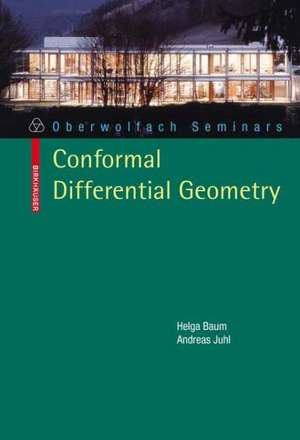Conformal Differential Geometry: Q-Curvature and Conformal Holonomy: Oberwolfach Seminars, cartea 40
Autor Helga Baum, Andreas Juhlen Limba Engleză Paperback – 14 ian 2010
The part on conformal holonomy describes recent classification results, its relation to Einstein metrics and to conformal Killing spinors, and related special geometries.
Din seria Oberwolfach Seminars
-
 Preț: 352.63 lei
Preț: 352.63 lei -
 Preț: 241.73 lei
Preț: 241.73 lei -
 Preț: 245.87 lei
Preț: 245.87 lei - 13%
 Preț: 356.03 lei
Preț: 356.03 lei -
 Preț: 361.63 lei
Preț: 361.63 lei -
 Preț: 379.30 lei
Preț: 379.30 lei -
 Preț: 343.72 lei
Preț: 343.72 lei -
 Preț: 485.46 lei
Preț: 485.46 lei -
 Preț: 352.25 lei
Preț: 352.25 lei -
 Preț: 486.54 lei
Preț: 486.54 lei -
 Preț: 352.41 lei
Preț: 352.41 lei -
 Preț: 274.54 lei
Preț: 274.54 lei -
 Preț: 385.62 lei
Preț: 385.62 lei -
 Preț: 380.07 lei
Preț: 380.07 lei -
 Preț: 315.18 lei
Preț: 315.18 lei - 15%
 Preț: 579.34 lei
Preț: 579.34 lei -
 Preț: 344.47 lei
Preț: 344.47 lei -
 Preț: 355.05 lei
Preț: 355.05 lei -
 Preț: 379.86 lei
Preț: 379.86 lei -
 Preț: 346.59 lei
Preț: 346.59 lei -
 Preț: 352.54 lei
Preț: 352.54 lei -
 Preț: 410.55 lei
Preț: 410.55 lei -
 Preț: 349.27 lei
Preț: 349.27 lei -
 Preț: 356.60 lei
Preț: 356.60 lei -
 Preț: 381.59 lei
Preț: 381.59 lei -
 Preț: 499.99 lei
Preț: 499.99 lei -
 Preț: 396.78 lei
Preț: 396.78 lei -
 Preț: 347.15 lei
Preț: 347.15 lei -
 Preț: 425.91 lei
Preț: 425.91 lei -
 Preț: 421.34 lei
Preț: 421.34 lei -
 Preț: 347.25 lei
Preț: 347.25 lei -
 Preț: 358.13 lei
Preț: 358.13 lei - 5%
 Preț: 581.41 lei
Preț: 581.41 lei -
 Preț: 431.35 lei
Preț: 431.35 lei -
 Preț: 279.94 lei
Preț: 279.94 lei -
 Preț: 270.09 lei
Preț: 270.09 lei -
 Preț: 355.52 lei
Preț: 355.52 lei -
 Preț: 360.92 lei
Preț: 360.92 lei -
 Preț: 242.00 lei
Preț: 242.00 lei -
 Preț: 573.72 lei
Preț: 573.72 lei -
 Preț: 458.78 lei
Preț: 458.78 lei -
 Preț: 346.66 lei
Preț: 346.66 lei -
 Preț: 493.51 lei
Preț: 493.51 lei -
 Preț: 416.92 lei
Preț: 416.92 lei -
 Preț: 415.95 lei
Preț: 415.95 lei -
 Preț: 353.18 lei
Preț: 353.18 lei
Preț: 350.72 lei
Nou
Puncte Express: 526
Preț estimativ în valută:
67.11€ • 70.26$ • 55.53£
67.11€ • 70.26$ • 55.53£
Carte disponibilă
Livrare economică 15-29 martie
Preluare comenzi: 021 569.72.76
Specificații
ISBN-13: 9783764399085
ISBN-10: 3764399082
Pagini: 152
Ilustrații: X, 152 p.
Dimensiuni: 170 x 240 x 15 mm
Greutate: 0.32 kg
Ediția:2010
Editura: Birkhäuser Basel
Colecția Birkhäuser
Seria Oberwolfach Seminars
Locul publicării:Basel, Switzerland
ISBN-10: 3764399082
Pagini: 152
Ilustrații: X, 152 p.
Dimensiuni: 170 x 240 x 15 mm
Greutate: 0.32 kg
Ediția:2010
Editura: Birkhäuser Basel
Colecția Birkhäuser
Seria Oberwolfach Seminars
Locul publicării:Basel, Switzerland
Public țintă
ResearchCuprins
Q-curvature.- Conformal holonomy.
Recenzii
From the reviews:
“This book grew out of an Oberwolfach student seminar on recent developments in conformal differential geometry which took place in 2007. It splits into two chapters, which to a large extent are independent of each other. Each of the chapters is an extended version of a series of lectures presented by one of the authors during the seminar and offers a nice and easily readable survey of an active area of research in conformal differential geometry.” (Andreas Cap, Mathematical Reviews, Issue 2011 d)
“This book grew out of an Oberwolfach student seminar on recent developments in conformal differential geometry which took place in 2007. It splits into two chapters, which to a large extent are independent of each other. Each of the chapters is an extended version of a series of lectures presented by one of the authors during the seminar and offers a nice and easily readable survey of an active area of research in conformal differential geometry.” (Andreas Cap, Mathematical Reviews, Issue 2011 d)
Textul de pe ultima copertă
Conformal invariants (conformally invariant tensors, conformally covariant differential operators, conformal holonomy groups etc.) are of central significance in differential geometry and physics. Well-known examples of conformally covariant operators are the Yamabe, the Paneitz, the Dirac and the twistor operator. These operators are intimely connected with the notion of Branson’s Q-curvature. The aim of these lectures is to present the basic ideas and some of the recent developments around Q -curvature and conformal holonomy.
The part on Q -curvature starts with a discussion of its origins and its relevance in geometry and spectral theory. The following lectures describe the fundamental relation between Q -curvature and scattering theory on asymptotically hyperbolic manifolds. Building on this, they introduce the recent concept of Q -curvature polynomials and use these to reveal the recursive structure of Q -curvatures.
The part on conformal holonomy starts with an introduction to Cartan connections and its holonomy groups. Then we define holonomy groups of conformal manifolds, discuss its relation to Einstein metrics and recent classification results in Riemannian and Lorentzian signature. In particular, we explain the connection between conformal holonomy and conformal Killing forms and spinors, and describe Fefferman metrics in CR geometry as Lorentzian manifold with conformal holonomy SU(1,m).
The part on Q -curvature starts with a discussion of its origins and its relevance in geometry and spectral theory. The following lectures describe the fundamental relation between Q -curvature and scattering theory on asymptotically hyperbolic manifolds. Building on this, they introduce the recent concept of Q -curvature polynomials and use these to reveal the recursive structure of Q -curvatures.
The part on conformal holonomy starts with an introduction to Cartan connections and its holonomy groups. Then we define holonomy groups of conformal manifolds, discuss its relation to Einstein metrics and recent classification results in Riemannian and Lorentzian signature. In particular, we explain the connection between conformal holonomy and conformal Killing forms and spinors, and describe Fefferman metrics in CR geometry as Lorentzian manifold with conformal holonomy SU(1,m).
Caracteristici
Reviews very recent developments Compact introduction into an active field of research


















